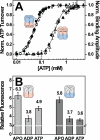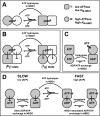Regulatory circuits of the AAA+ disaggregase Hsp104
- PMID: 21454552
- PMCID: PMC3093873
- DOI: 10.1074/jbc.M110.216176
Regulatory circuits of the AAA+ disaggregase Hsp104
Abstract
Yeast Hsp104 is an AAA+ chaperone that rescues proteins from the aggregated state. Six protomers associate to form the functional hexamer. Each protomer contains two AAA+ modules, NBD1 and NBD2. Hsp104 converts energy provided by ATP into mechanical force used to thread polypeptides through its axial channel, thereby disrupting protein aggregates. But how the action of its 12 AAA+ domains is co-ordinated to catalyze disaggregation remained unexplained. Here, we identify a sophisticated allosteric network consisting of three distinct pathways that senses the nucleotide state of AAA+ modules and transmits this information across the Hsp104 hexamer. As a result of this communication, NBD1 and NBD2 each adopt two distinct conformations (relaxed and tense) that are reciprocally regulated. The key element in the network is the NBD1-ATP state that enables Hsp104 to switch from a barely active [(T)(R)] state to a highly active [(R)(T)] state. This concerted switch involves both cis and trans protomer interactions and provides Hsp104 with the mechanistic scaffold to catalyze disaggregation. It prepares the chaperone for polypeptide binding and activates NBD2 to generate the power strokes required to resolve protein aggregates. ATP hydrolysis in NBD1 resolves the high affinity [(R)(T)] state and switches the chaperone back into the low affinity [(T)(R)] state. Our model integrates previously unexplained observations and provides the first comprehensive map of nucleotide-related allosteric signals in a class-1 AAA+ protein.
© 2011 by The American Society for Biochemistry and Molecular Biology, Inc.
Figures







Similar articles
-
Cooperative kinetics of both Hsp104 ATPase domains and interdomain communication revealed by AAA sensor-1 mutants.EMBO J. 2002 Jan 15;21(1-2):12-21. doi: 10.1093/emboj/21.1.12. EMBO J. 2002. PMID: 11782421 Free PMC article.
-
Processing of proteins by the molecular chaperone Hsp104.J Mol Biol. 2007 Jul 20;370(4):674-86. doi: 10.1016/j.jmb.2007.04.070. Epub 2007 May 5. J Mol Biol. 2007. PMID: 17543332
-
Analysis of the AAA sensor-2 motif in the C-terminal ATPase domain of Hsp104 with a site-specific fluorescent probe of nucleotide binding.Proc Natl Acad Sci U S A. 2002 Mar 5;99(5):2732-7. doi: 10.1073/pnas.261693199. Epub 2002 Feb 26. Proc Natl Acad Sci U S A. 2002. PMID: 11867765 Free PMC article.
-
Mechanistic and Structural Insights into the Prion-Disaggregase Activity of Hsp104.J Mol Biol. 2016 May 8;428(9 Pt B):1870-85. doi: 10.1016/j.jmb.2015.11.016. Epub 2015 Dec 1. J Mol Biol. 2016. PMID: 26608812 Free PMC article. Review.
-
Spiraling in Control: Structures and Mechanisms of the Hsp104 Disaggregase.Cold Spring Harb Perspect Biol. 2019 Aug 1;11(8):a034033. doi: 10.1101/cshperspect.a034033. Cold Spring Harb Perspect Biol. 2019. PMID: 30745294 Free PMC article. Review.
Cited by
-
Structural Elements Regulating AAA+ Protein Quality Control Machines.Front Mol Biosci. 2017 May 4;4:27. doi: 10.3389/fmolb.2017.00027. eCollection 2017. Front Mol Biosci. 2017. PMID: 28523272 Free PMC article. Review.
-
Tuning Hsp104 specificity to selectively detoxify α-synuclein.Mol Cell. 2023 Sep 21;83(18):3314-3332.e9. doi: 10.1016/j.molcel.2023.07.029. Epub 2023 Aug 24. Mol Cell. 2023. PMID: 37625404 Free PMC article.
-
Suramin inhibits Hsp104 ATPase and disaggregase activity.PLoS One. 2014 Oct 9;9(10):e110115. doi: 10.1371/journal.pone.0110115. eCollection 2014. PLoS One. 2014. PMID: 25299406 Free PMC article.
-
ATP-driven molecular chaperone machines.Biopolymers. 2013 Nov;99(11):846-59. doi: 10.1002/bip.22361. Biopolymers. 2013. PMID: 23877967 Free PMC article. Review.
-
Modular and coordinated activity of AAA+ active sites in the double-ring ClpA unfoldase of the ClpAP protease.Proc Natl Acad Sci U S A. 2020 Oct 13;117(41):25455-25463. doi: 10.1073/pnas.2014407117. Epub 2020 Oct 5. Proc Natl Acad Sci U S A. 2020. PMID: 33020301 Free PMC article.
References
-
- Ogura T., Wilkinson A. J. (2001) Genes Cells 6, 575–597 - PubMed
-
- Erzberger J. P., Berger J. M. (2006) Annu. Rev. Biophys. Biomol. Struct. 35, 93–114 - PubMed
-
- Parsell D. A., Kowal A. S., Singer M. A., Lindquist S. (1994) Nature 372, 475–478 - PubMed
-
- Sanchez Y., Lindquist S. L. (1990) Science 248, 1112–1115 - PubMed
MeSH terms
Substances
LinkOut - more resources
Full Text Sources
Molecular Biology Databases
Research Materials
Miscellaneous

